 They call it a piece of Hawaii in the Philippines. But indeed, the Mount Malarayat Golf and Country Club in Lipa, Batangas offers some of the best views of Philippine landscape architecture at its finest. I was lucky to spend a relaxing day enjoying the serene views of a well-landscaped golf course amidst the backdrop of Mount Malarayat. Such a conducive place for a meeting that would otherwise have been quite exhausting if not for the great view from the function room.It turns out, the landscape architects were led by none other than National Artist for Architecture, Ildefonso P. Santos and Associates as well as Pesons, Dimanlig, Aleta, Alcazaren (PDAA) Partners whom I believe are professors of landscape architecture at the University of the Philippines.I hope we get more of the Philippines landscaped by professionals!
They call it a piece of Hawaii in the Philippines. But indeed, the Mount Malarayat Golf and Country Club in Lipa, Batangas offers some of the best views of Philippine landscape architecture at its finest. I was lucky to spend a relaxing day enjoying the serene views of a well-landscaped golf course amidst the backdrop of Mount Malarayat. Such a conducive place for a meeting that would otherwise have been quite exhausting if not for the great view from the function room.It turns out, the landscape architects were led by none other than National Artist for Architecture, Ildefonso P. Santos and Associates as well as Pesons, Dimanlig, Aleta, Alcazaren (PDAA) Partners whom I believe are professors of landscape architecture at the University of the Philippines.I hope we get more of the Philippines landscaped by professionals!
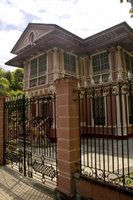 I'm not talking about bacon, lettuce and tomato. If you've heard about that bus company with the acronym BLTB Co. and know what it stands for, then you know where I was this time around. Hehe! Yup, it was another round of Batangas, Laguna and Quezon Province (Tayabas). The main destination was another heritage town which I've been wanting to visit since my trip to Sariaya, Quezon last year.It was just a few kilometers away, separated only by the town of Candelaria. Had I known during last year's Pahiyas trip what was waiting to be seen there, we would have stopped by. That town is San Juan, Batangas, another community that prospered early in the 20th Century as a result of the coconut boom. It is more known for its popular beach resorts such as La Luz. But few people realize that just like Sariaya, the town is littered with elegant pre-WWII mansions.
I'm not talking about bacon, lettuce and tomato. If you've heard about that bus company with the acronym BLTB Co. and know what it stands for, then you know where I was this time around. Hehe! Yup, it was another round of Batangas, Laguna and Quezon Province (Tayabas). The main destination was another heritage town which I've been wanting to visit since my trip to Sariaya, Quezon last year.It was just a few kilometers away, separated only by the town of Candelaria. Had I known during last year's Pahiyas trip what was waiting to be seen there, we would have stopped by. That town is San Juan, Batangas, another community that prospered early in the 20th Century as a result of the coconut boom. It is more known for its popular beach resorts such as La Luz. But few people realize that just like Sariaya, the town is littered with elegant pre-WWII mansions.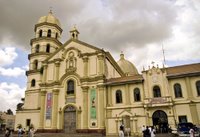 We left Manila after rush hour for what was to be a quick leisurely drive to Batangas. We were quite surprised we were in Sto. Tomas, Batangas in no time, which is the entry point of the STAR Tollway to Lipa City. I hope they make more of these roads in the provinces since passing by town poblacions is just too frustrating no thanks to the tricycles.
We left Manila after rush hour for what was to be a quick leisurely drive to Batangas. We were quite surprised we were in Sto. Tomas, Batangas in no time, which is the entry point of the STAR Tollway to Lipa City. I hope they make more of these roads in the provinces since passing by town poblacions is just too frustrating no thanks to the tricycles.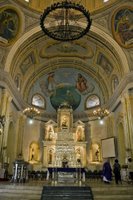 Before proceeding to San Juan, we decided to make a stopover at the San Sebastian Cathedral, the seat of the Archdiocese of Lipa. The Romanesque church was completed in 1865 but just like much, if not most of our architectural heritage, it was devastated during the war with the current cathedral a result of massive reconstruction and restoration. What attracted me to the cathedral were photos of its wall and ceiling murals. But upon entering, I was quite disappointed.At the back were paintings of the twelve apostles. But the images and poses were so Hollywood, most probably taken from Franco Zeffirelli's 1977 movie Jesus of Nazareth! Talk about taste in a heritage church! The rest of the murals were ok and thankfully not as bad as those at the back. I guess Betis, Pampanga still tops the list for the best church murals, living up to its moniker of Sistine Chapel of the Philippines.
Before proceeding to San Juan, we decided to make a stopover at the San Sebastian Cathedral, the seat of the Archdiocese of Lipa. The Romanesque church was completed in 1865 but just like much, if not most of our architectural heritage, it was devastated during the war with the current cathedral a result of massive reconstruction and restoration. What attracted me to the cathedral were photos of its wall and ceiling murals. But upon entering, I was quite disappointed.At the back were paintings of the twelve apostles. But the images and poses were so Hollywood, most probably taken from Franco Zeffirelli's 1977 movie Jesus of Nazareth! Talk about taste in a heritage church! The rest of the murals were ok and thankfully not as bad as those at the back. I guess Betis, Pampanga still tops the list for the best church murals, living up to its moniker of Sistine Chapel of the Philippines.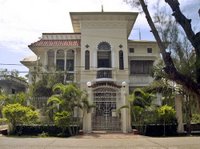
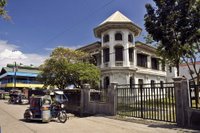 With that done, it was off to San Juan. We arrived just in time for lunch. So after a short familiarization drive around, we looked for a place to eat. And since the summer heat was getting to be unbearable, we looked for the first air-conditioned restaurant we could find. I think the place we ate at was the only one in the poblacion... hehehe!After lunch, it was time for photos. My Canon camera is still under repair (they recalled certain models due to manufacturing defects), so I'm relying on Karlo de Leon's photos for this entry. If documenting heritage were a crime, then I guess partners in crime would be an apt description since we're both heritage addicts. Hehe!
With that done, it was off to San Juan. We arrived just in time for lunch. So after a short familiarization drive around, we looked for a place to eat. And since the summer heat was getting to be unbearable, we looked for the first air-conditioned restaurant we could find. I think the place we ate at was the only one in the poblacion... hehehe!After lunch, it was time for photos. My Canon camera is still under repair (they recalled certain models due to manufacturing defects), so I'm relying on Karlo de Leon's photos for this entry. If documenting heritage were a crime, then I guess partners in crime would be an apt description since we're both heritage addicts. Hehe!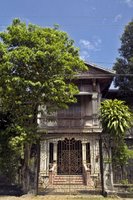
 The houses are scattered around the town. But it was obvious that the San Juan mark was fast disappearing due to modernization, possibly evolving into another nondescript Filipino town. Unlike Sariaya which has its town character quite intact, modern structures sprout like mushrooms in between heritage houses, obviously out of place. If San Juan is indeed serious in maximizing its heritage potential, it should enact a local ordinance that would regulate the scale and facades of new structures, similar to what we've done in the City of San Fernando. If we only had that much heritage in San Fernando intact! But we lost a lot in the Philippine-American War, WWII and the floods that hit Pampanga after the Mt. Pinatubo eruption. In fact, the chalets in our American quarter are half-buried after the roads were raised by at least a meter.We didn't want to go back via Lipa since traffic management there was bad. So we decided to go home via Tiaong and San Pablo City, Laguna. And since we were in the City of Seven Lakes, we decided to check out some of them.
The houses are scattered around the town. But it was obvious that the San Juan mark was fast disappearing due to modernization, possibly evolving into another nondescript Filipino town. Unlike Sariaya which has its town character quite intact, modern structures sprout like mushrooms in between heritage houses, obviously out of place. If San Juan is indeed serious in maximizing its heritage potential, it should enact a local ordinance that would regulate the scale and facades of new structures, similar to what we've done in the City of San Fernando. If we only had that much heritage in San Fernando intact! But we lost a lot in the Philippine-American War, WWII and the floods that hit Pampanga after the Mt. Pinatubo eruption. In fact, the chalets in our American quarter are half-buried after the roads were raised by at least a meter.We didn't want to go back via Lipa since traffic management there was bad. So we decided to go home via Tiaong and San Pablo City, Laguna. And since we were in the City of Seven Lakes, we decided to check out some of them.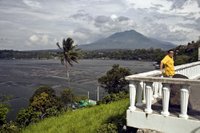 Of course, the most prominent of the lakes is Sampalok. At 104 hectares, it is the biggest of the seven lakes and located in the city proper. It was the first lake we visited. The view of Mount Banahaw as a backdrop to the lake was just awesome. But we were in the mood for adventure so we asked around how to get to the others. Since we didn't have time to visit all, we asked for the best one, regardless of distance. And according to those we asked, it was Calibato Lake in Barangay Sto. Angel, which was at the boundary with the town of Rizal, Laguna.
Of course, the most prominent of the lakes is Sampalok. At 104 hectares, it is the biggest of the seven lakes and located in the city proper. It was the first lake we visited. The view of Mount Banahaw as a backdrop to the lake was just awesome. But we were in the mood for adventure so we asked around how to get to the others. Since we didn't have time to visit all, we asked for the best one, regardless of distance. And according to those we asked, it was Calibato Lake in Barangay Sto. Angel, which was at the boundary with the town of Rizal, Laguna.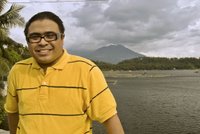 On the way they, we passed by Palakpakin Lake in Barangay San Buenaventura. It has an area of 43 hectares, and looks similar to Sampalok. This time, there were lesser signs of progress and thus, a better view of Banahaw. We took shots from a bridge and moved on to our final destination, Calibato.
On the way they, we passed by Palakpakin Lake in Barangay San Buenaventura. It has an area of 43 hectares, and looks similar to Sampalok. This time, there were lesser signs of progress and thus, a better view of Banahaw. We took shots from a bridge and moved on to our final destination, Calibato. It was difficult looking for Calibato since it was not along the road and you had to hike a bit to get there. After asking around, we finally found the point from where to start the hike down to the 42-hectare crater lake. We didn't know what to expect or how far the lake was from where we parked. Just looking at the downward steps made us imagine the effort it would entail to get back up. Pant! Pant! Hehe! But as we neared the lake, the narrow canyon carved by the small stream increased the level of excitement. I hope we are able to preserve what is left of nature here in the county.
It was difficult looking for Calibato since it was not along the road and you had to hike a bit to get there. After asking around, we finally found the point from where to start the hike down to the 42-hectare crater lake. We didn't know what to expect or how far the lake was from where we parked. Just looking at the downward steps made us imagine the effort it would entail to get back up. Pant! Pant! Hehe! But as we neared the lake, the narrow canyon carved by the small stream increased the level of excitement. I hope we are able to preserve what is left of nature here in the county.
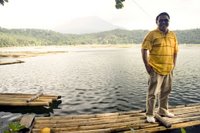 The effort was most worth it as we were rewarded with a spectacular view surrounded by the charm of a traditional fishing community. What a way to cap another day of pleasant surprises.
The effort was most worth it as we were rewarded with a spectacular view surrounded by the charm of a traditional fishing community. What a way to cap another day of pleasant surprises.
 They call it a piece of Hawaii in the Philippines. But indeed, the Mount Malarayat Golf and Country Club in Lipa, Batangas offers some of the best views of Philippine landscape architecture at its finest. I was lucky to spend a relaxing day enjoying the serene views of a well-landscaped golf course amidst the backdrop of Mount Malarayat. Such a conducive place for a meeting that would otherwise have been quite exhausting if not for the great view from the function room.
They call it a piece of Hawaii in the Philippines. But indeed, the Mount Malarayat Golf and Country Club in Lipa, Batangas offers some of the best views of Philippine landscape architecture at its finest. I was lucky to spend a relaxing day enjoying the serene views of a well-landscaped golf course amidst the backdrop of Mount Malarayat. Such a conducive place for a meeting that would otherwise have been quite exhausting if not for the great view from the function room.










